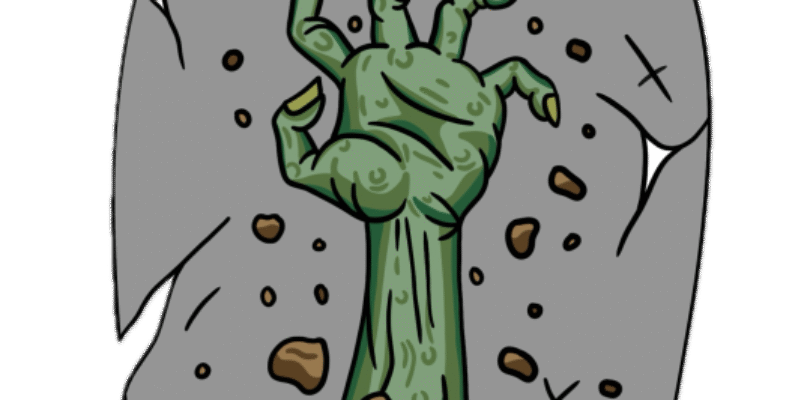See the link here: to see how far you’d survive in a zombie apocalypse.
It’s a beautiful day on campus. Maybe you’re on Ankeny playing hackey sack. Maybe you’re in the library wishing you could be playing hackey sack. Either way, it’s calm and peaceful. Until, suddenly, it isn’t. Your phone goes off unexpectedly, making an unusually loud, grating noise. Other people’s phones are also going off. You check the message:
EMERGENCY ALERT SYSTEM
WALLA WALLA EMERGENCY MANAGEMENT HAS ISSUED AN EMERGENCY ALERT FOR THE WALLA WALLA COUNTY REGION
REPORTS OF VIOLENT ACTIVITY
WIDESPREAD LOOTING
RESIDENTS ARE ADVISED TO STAY INDOORS
LOCK ALL DOORS AND WINDOWS
There’s a growing commotion on Ankeny. Professors and students are brawling – you’re pretty sure you just saw Sarah Bolton bite a student. You follow the instructions on your phone and barricade yourself in the library bathroom. Safe, for now. [for more choose your own adventure go to QR code]
The zombie apocalypse (whether inevitable or the stuff of pure fantasy) has a stronghold on our imaginations and pop culture. This year alone, zombie fans can enjoy a new season of The Last of Us on Max and, in June, catch 28 Years Later – the 3rd movie in the 28 Days Later zombie apocalypse franchise. But what would a zombie apocalypse look like in ‘real’ life? And, what viruses, bacteria or fungus might cause a real-life apocalypse?
In Walla Walla, where the population of roughly 62,000 live in rural, somewhat isolated conditions, a zombie virus outbreak may not be the end of the world (so to speak). Director of Walla Walla County Emergency Management Chris Lee and the Coordinator for Walla Walla County Emergency Management Patrick Purcell say that, in the case of an infectious disease emergency, many different organizations in the County would collaborate to provide timely aid and information to residents.
“There’s a thing within [the] incident command system that deals with an event that involves multiple organizations to tackle one situation,” said Lee, “so it could deal with law enforcement, fire, public works, it could impact the school.”
During the COVID-19 pandemic, for example, the Emergency Management team distributed almost 2 million pieces of Personal Protective Equipment (PPE) and took steps to support local food banks and healthcare centers.
In the case of disease outbreaks, however, Lee and Purcell emphasize that the Health Department would be making “all of the fundamental decisions.”
“We’re gonna essentially parrot whatever they determined to be the best courses of action,” said Purcell, “during Covid, it meant a lot of the messaging that we put out was generic.”
Internal documents from the Walla Walla County Department of Community Health’s efforts to protect the public from Highly Pathogenic Avian Influenza may provide a hint at how a zombie virus would be mitigated.
A “Provider Alert” issued by the department last July, before any human HPAI cases were detected in Washington, encourages providers to consider HPAI infection in patients with flu-like illness, and to assess these patients for animal exposures.
Another alert issued by the department in October, when the first human HPAI cases were detected in Washington, provides more in-depth information on what symptoms healthcare providers should watch for.
The alert reads, in part: “Clinicians in Washington should consider avian influenza infection in patients who present with acute respiratory illness, isolated conjunctivitis, or influenza-like illness (ILI), and to assess patients for exposures to animals (poultry, cattle, wildlife, or other animals) or people suspected or known to be infected with avian influenza.”
If a zombie pathogen began to spread in Walla Walla, it’s likely that similar alerts would be sent to healthcare providers. The alerts may even look eerily similar if, as is frequently the case in zombie fiction, the disease comes from animals.
Associate Professor of Biochemistry, Biophysics and Molecular Biology Jim Russo says that most recently emerging infectious diseases are zoonotic meaning “they mostly emerge from transmission from other species into humans.”
With most emerging infections occurring through zoonosis, including COVID-19, Russo says a new spotlight has been placed on our global connections.
“That creates a great opportunity to look at, how do you understand modern society with people traveling around the globe and the ability to get a disease from one part of the world to any other, and spreading within a 12 hour timeframe,” said Russo.
Russo says our fascination with zombie apocalypses is, in part, a function of our anxiety about the human condition.
“Infectious disease encounters with humans is not something that we had conquered in the mid 20th century, but that is part of the human condition. We have always had to contend with microbes for our survival,” said Russo.
The question remains, what would a zombie apocalypse look like in Walla Walla? What would happen if one microbe, for instance, became the biggest threat to our survival yet?
Zombies in the Wheat Fields
Since most emerging infections come from animals, as opposed to, say, a fungus that invades our food system a la The Last of Us, we will assume that this zombie pathogen has also come from animals. More specifically, monkeys.
Some of our most familiar diseases come from monkeys, including Malaria which is widely believed to have come from African apes and, in some cases, pig-tailed Macacques. Perhaps this is why, in the zombie apocalypse film 28 Days Later, the ‘Rage Virus’ comes from monkeys kept in a research lab.
So, a virus has jumped from a monkey to a human. The causes are too many to name – perhaps deforestation facilitated increased contact with humans and monkeys. Perhaps (as is imagined in the movie ‘Outbreak’) a pet monkey carrying the novel disease is shipped to the United States and sold at a pet store. It’s possible that we will never know the true cause of this outbreak.
Symptoms begin like the flu. A fever, muscle aches, lethargy. As the virus works its way through your nervous system, you start to experience changes in your mood. Suddenly, you are more irritable – you have a harder time speaking and thinking. You develop sensitivity to light – in fact, even the faintest beams of sunlight in your room feel blinding. Much like the rabies virus, which affects your central nervous system, this new pathogen is binding to your neurons. The disease is now in your brain.
Unlike the creative liberties taken in The Last of Us or 28 Days Later, it is highly unlikely that a pathogen could survive, and continue reproducing, in your body once you are dead. So, this pathogen has to keep you alive while slowly taking control over your autonomic functions and, eventually, your thoughts. Because, of course, a zombie only has one all-consuming thought: the hunger for human flesh.
Assuming (and here, we have to assume quite a bit) that this remarkable pathogen accomplishes all of this – congratulations, you are now a zombie.
Walla Walla is situated in a geographic river-basin. If you know your history, you’ll know that this is not ideal for defending against hordes of people who want to kill you. Consider George Washington’s infamous defeat at Fort Necessity – seriously, who builds a fort in a meadow?
We’re already off to a bad start, but it gets worse; we’re college students. And, Peter Harvey has retired – so we don’t have a czar to guide us through this new pandemic. At Whitman, where we live in close proximity to each-other, and many of us don’t have an easy means of escape (remember when we were told not to bring cars to campus?), this virus will spread like wildfire. Imagine Jewett chock-full of zombies (not unlike a typical Friday night), and your favorite professors’ offices barricaded with pieces of really uncomfortable furniture.
Farmers in the wheat fields have another problem. At its peak height before harvest, wheat can reach up to four feet tall. That’s more than enough height to hide hordes of creepy crawling zombies. And tractors, notoriously, don’t move very fast. For now, it’s best to avoid the wheat fields on your way out of town.
While you’re fighting for your life at Cleve, a meeting is taking place with the Fire Department, the Police, Emergency Management, the Health Department and others. They’re trying to figure out how to respond to a situation that appears to be rapidly spiraling out of control. While the health department works on alerts to healthcare providers, and determining how best to contain the spread of this disease, emergency management will also be thinking about another important element to survival – food and water.
“Most of the supplies that we’re receiving, food, groceries, gas, they all start West and come East,” said Purcell.
In the event of an emergency that decimates the West Coast, like the Cascadia fault, or, in our case, zombies, our daily necessities may quickly be in short supply. Not to mention, grocery stores and gas stations are notorious places to be attacked by zombies. So, Purcell and Lee say it’s best to already be prepared with enough food and water to survive for at least “three days or two weeks.”
There are a few ways out of Walla Walla. Assuming you’re not a zombie by now, and you’ve managed to hitch a ride out of town, your next challenge is making it out of the county or, even, the state. Is there enough gas in your car? Will you risk stopping at a potentially treacherous gas station? What direction are you going to drive in?
See the link here: to see how far you’d survive in a zombie apocalypse. And, in the meantime, as Lee and Purcell point out; start thinking about what you can do to prepare for any emergency.




